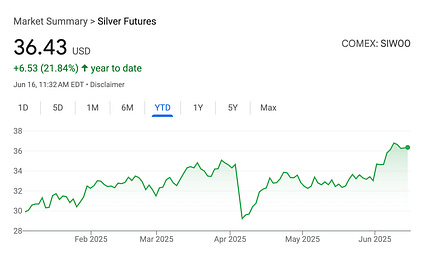You are a free subscriber to Me and the Money Printer. To upgrade to paid and receive the daily Capital Wave Report - which features our Red-Green market signals, subscribe here. Dear Fellow Traveler: Goldman Sachs is at it again. The investment bank notorious for saying one thing and going in the opposite direction (John Paulsen 2008, Oil Prices 2008) is hawking stocks. Today, analysts promote the good old “There is No Alternative” narrative for investing. It’s the idea that investors should concentrate all their assets into a single asset class because there is no alternative to stocks. (How nice of an investment bank that makes a killing from trading to pump stocks.) The statement comes as retail investors continue to buy up stocks at a record pace. The problem is that most retail investors also run for the exits faster than anyone else during a crisis. So—if you’re playing the TINA game, you’d better pay attention. Because not only are stocks the most dangerous game in this environment… There is an alternative… What Goldman SaidAgain, TINA stands for "There Is No Alternative." It suggests that investors favor U.S. stocks because other options (bonds, cash, international markets) offer poor returns or higher risks. The acronym gained popularity during the 2010s low-interest-rate environment when bonds yielded little. Goldman Sachs strategists, led by David Kostin, are forecasting $425 billion in household equity purchases for 2025, saying "the TINA trade remains alive and well." They cite retail investors buying $20 billion in stocks over three months (88th percentile pace vs. 5-year average), with households directly owning 38% of U.S. stocks. Goldman expounded on buying because typical outflow triggers—weakening balance sheets, high unemployment, or rising short-term rates—are absent. They highlight 401(k) plans as a key driver, with equity allocations rising from 66% (2013) to 71% (2022), supporting their bullish household demand outlook. The company has maintained a 2025 forecast for the S&P 500 at 6,500. Challenging the LogicWe need to note a few things about Goldman’s argument. First, we maintain that investors are not being pushed into markets by any underlying macroeconomic drivers. It’s Fear of Missing Out combined with strong liquidity flows anchored on the back of Treasury Activity (their form of easing). Never-ending money printing has created a viable alternative, especially when markets ebb and flow based on the amount of available capital sloshing through the system. And, the most viable hedge for the money printer is precious metals, which outperform stocks this year. Gold has jumped over 28% in 2025, significantly outperforming many equity markets. Following gold's 2025 rally, silver jumped to its highest level in 13 years, up 21.8% this year. These aren't just defensive plays—they're delivering superior returns. But it’s not just that there’s an alternative. It’s that equities are constantly under pressure when liquidity challenges persist. Why Investors Should Not Chase FOMOAs noted, momentum and liquidity have driven this market post-COVID. Central fiscal policy's incredible surge of activity has provided backdoor stimulus and support to equity markets. But sometimes, there are breakdowns or problems with the financial plumbing, a hiccup in the nonstop financialization that drives international markets. In the last four years alone, four four-sigma or higher events have transpired. They were:
Those events are supposed to be once-in-63-year events, and they’re happening regularly. Each of these events likely drove massive retail redemptions that Goldman's current "88th percentile buying" data doesn't reflect in real time. Retail investors have experienced four separate "black swan" moments in which their portfolios were decimated quickly. The problem with these moves is that retail investors aren't making rational long-term allocation decisions—they're trauma-responding to repeated portfolio destruction. In addition, the 401(k) plans Goldman celebrates are mostly automatic contributions, not active investment choices. Finally, after four major downturns, many retail investors probably rotate to assets like gold and silver that don't gap down 20% in a month. The money printer will go BRRR. Stay diversified, focus on real assets that generate lots of cash, and don’t chase just for the sake of chasing. Stay positive, Garrett Baldwin About Me and the Money Printer Me and the Money Printer is a daily publication covering the financial markets through three critical equations. We track liquidity (money in the financial system), momentum (where money is moving in the system), and insider buying (where Smart Money at companies is moving their money). Combining these elements with a deep understanding of central banking and how the global system works has allowed us to navigate financial cycles and boost our probability of success as investors and traders. This insight is based on roughly 17 years of intensive academic work at four universities, extensive collaboration with market experts, and the joy of trial and error in research. You can take a free look at our worldview and thesis right here. Disclaimer Nothing in this email should be considered personalized financial advice. While we may answer your general customer questions, we are not licensed under securities laws to guide your investment situation. Do not consider any communication between you and Florida Republic employees as financial advice. The communication in this letter is for information and educational purposes unless otherwise strictly worded as a recommendation. Model portfolios are tracked to showcase a variety of academic, fundamental, and technical tools, and insight is provided to help readers gain knowledge and experience. Readers should not trade if they cannot handle a loss and should not trade more than they can afford to lose. There are large amounts of risk in the equity markets. Consider consulting with a professional before making decisions with your money. |
Subscribe to:
Post Comments (Atom)




0 Response to "There Is No Alternative?"
Post a Comment